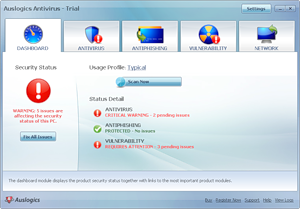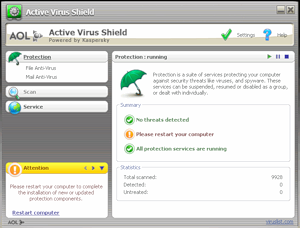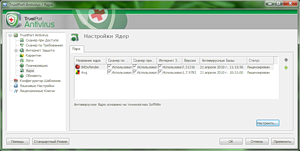Engine - the heart of the antivirus
Perhaps an antivirus is one of the most complex products among those installed on a typical home computer. It must process all the information turned by the computer and coming from outside. Check each file for compliance with one of the more than four million signatures, monitor network activity, cut banners — all without compromising resources and leaving a chance to viruses. This is not the html-code to parse and do not handle keystrokes with the subsequent insertion of the corresponding letters into the document.
No, antivirus is an extremely high-tech product, on which many specialists have worked. And, it would seem, their work should be the basis of the entire company, and the core of the antivirus, its engine, with seven seals in a steel safe behind a triple protection ring.
Antivirus companies are laughing fiercely at everyone who thought so. Licensing the engine to third-party companies for some of the relevant organizations is perhaps more serious business than the actual retail sales of the product.
A typical licensing situation for an engine looks like this:
And, characteristically, this model is well honed and practiced by many companies. Especially in the field of licensing succeeded one Romanian company. Find the 10 differences:
BitDefender Antivirus 2010:

Acronis Antivirus:

Auslogics Antivirus:

In addition, BitDefender uses Bullguard and F-Secure. The latter, along with the third-party engine, uses its own developments. And nice.
')
I promised to elaborate on this point. Everything is clear in terms of income, but there is another hidden profit. Namely - advertising. Consider an example.
Back in 2007, the product ActiveVirusShield was released from AOL, the core of which was taken from Kaspersky Anti-Virus version 6.

As you can see, the window has an inconspicuous inscription "Powered by Kaspersky". I do not know what the users thought, what they did, but:
Here is Amazon.com on January 1, 2007 (antivirus section):
web.archive.org/web/20061211182029/www.amazon.com/Virus-Protection-Utilities-Software/b?ie=UTF8&node=229677
On the first places in sales are products from Microsoft and ZoneAlarm.
Here is Amazon.com in 355 days (the same section):
web.archive.org/web/20071225054312rn_1/www.amazon.com/Virus-Protection-Utilities-Software/b?ie=UTF8&node=229677
Both main products of the Laboratory are in the first place.
For the year, sales growth reached record numbers. Largely due to collaboration with AOL.
Science is not aware of such a human heart disease, which is probably not surprising. It is difficult to imagine a situation with more than one number of hearts.
But multi-motion antiviruses also exist quite successfully. Although, nevertheless, today this product remains quite specific.
What's the point?
+ The reliability that one antivirus will miss will catch another.
- It is difficult to ensure complete stability of the structure, which leads to failures.
- Used, respectively, a larger number of resources compared with the usual antivirus.
- Theoretically, there should be a higher price for the final product (two engines must be licensed at once). In practice, the difference is not visible.
As you can see, there are more minuses than pluses, but still there are companies that are pulling for experiments.
The most famous product, as I see it, is G-Data Antivirus. The product from the German company combines two anti-virus kernels: Avast! and ... well, I think you already guessed that it could not have happened without our Romanian friend.
ru.gdatasoftware.com
In another way, Ashampoo went. Another German company combines Ikarus anti-virus kernel with a-squared anti-spyware module. There is already difficult to argue, the decision seems to be very reasonable.
www2.ashampoo.com/webcache/html/1/product_2_0249___USD.htm
Czechs from the TrustPort company also decided to include two engines in their antivirus. One of them is clear what, the other - from the Czech AVG Technologies, which produces the same antivirus. The company does not hesitate and offers information on each of the cores:

www.trustport.com
Well, and finally, I will offer you to get acquainted with the product of the Ukrainian company NuWave Software, which develops MultiCore Antivirus. The anti-virus includes, attention, 5 anti-virus kernels: AVG, F-Prot, Ad-Aware, Norman, Vipre. Honestly, I did not dare to establish this monster, therefore,% habrinhabitant%, flag in your hands.
www.nuwavesoft.com/nuwave.html
Antivirus engines licensing is a secret business and a magic wand of someRomanian antivirus companies. I hope the reader was interested in learning more about this and reading my opus did not turn into a waste of time :)
Good luck!
No, antivirus is an extremely high-tech product, on which many specialists have worked. And, it would seem, their work should be the basis of the entire company, and the core of the antivirus, its engine, with seven seals in a steel safe behind a triple protection ring.
Antivirus companies are laughing fiercely at everyone who thought so. Licensing the engine to third-party companies for some of the relevant organizations is perhaps more serious business than the actual retail sales of the product.
Engine Licensing as a Business Model
A typical licensing situation for an engine looks like this:
- Company A wants to enter a new market for itself - antivirus.
- But she does not have enough resources to make your own product.
- Company A licenses engine from Company B and changes its copyright.
- Company A receives $$, and Company B receives an additional source of income in the form of interest on sales and access to new markets (more details below).
- ...
- All PROFIT !!!
And, characteristically, this model is well honed and practiced by many companies. Especially in the field of licensing succeeded one Romanian company. Find the 10 differences:
BitDefender Antivirus 2010:

Acronis Antivirus:

Auslogics Antivirus:

In addition, BitDefender uses Bullguard and F-Secure. The latter, along with the third-party engine, uses its own developments. And nice.
')
Benefit for company B
I promised to elaborate on this point. Everything is clear in terms of income, but there is another hidden profit. Namely - advertising. Consider an example.
Back in 2007, the product ActiveVirusShield was released from AOL, the core of which was taken from Kaspersky Anti-Virus version 6.

As you can see, the window has an inconspicuous inscription "Powered by Kaspersky". I do not know what the users thought, what they did, but:
Here is Amazon.com on January 1, 2007 (antivirus section):
web.archive.org/web/20061211182029/www.amazon.com/Virus-Protection-Utilities-Software/b?ie=UTF8&node=229677
On the first places in sales are products from Microsoft and ZoneAlarm.
Here is Amazon.com in 355 days (the same section):
web.archive.org/web/20071225054312rn_1/www.amazon.com/Virus-Protection-Utilities-Software/b?ie=UTF8&node=229677
Both main products of the Laboratory are in the first place.
For the year, sales growth reached record numbers. Largely due to collaboration with AOL.
Polycardite
Science is not aware of such a human heart disease, which is probably not surprising. It is difficult to imagine a situation with more than one number of hearts.
But multi-motion antiviruses also exist quite successfully. Although, nevertheless, today this product remains quite specific.
What's the point?
+ The reliability that one antivirus will miss will catch another.
- It is difficult to ensure complete stability of the structure, which leads to failures.
- Used, respectively, a larger number of resources compared with the usual antivirus.
- Theoretically, there should be a higher price for the final product (two engines must be licensed at once). In practice, the difference is not visible.
As you can see, there are more minuses than pluses, but still there are companies that are pulling for experiments.
The most famous product, as I see it, is G-Data Antivirus. The product from the German company combines two anti-virus kernels: Avast! and ... well, I think you already guessed that it could not have happened without our Romanian friend.
ru.gdatasoftware.com
In another way, Ashampoo went. Another German company combines Ikarus anti-virus kernel with a-squared anti-spyware module. There is already difficult to argue, the decision seems to be very reasonable.
www2.ashampoo.com/webcache/html/1/product_2_0249___USD.htm
Czechs from the TrustPort company also decided to include two engines in their antivirus. One of them is clear what, the other - from the Czech AVG Technologies, which produces the same antivirus. The company does not hesitate and offers information on each of the cores:

www.trustport.com
Well, and finally, I will offer you to get acquainted with the product of the Ukrainian company NuWave Software, which develops MultiCore Antivirus. The anti-virus includes, attention, 5 anti-virus kernels: AVG, F-Prot, Ad-Aware, Norman, Vipre. Honestly, I did not dare to establish this monster, therefore,% habrinhabitant%, flag in your hands.
www.nuwavesoft.com/nuwave.html
Conclusion
Antivirus engines licensing is a secret business and a magic wand of some
Good luck!
Source: https://habr.com/ru/post/96651/
All Articles